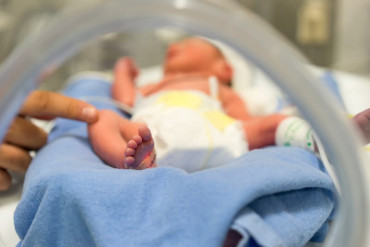What Is Periventricular Leukomalacia?

Periventricular leukomalacia (PVL) is a brain injury that occurs in premature babies. PVL causes the decay or damage of the white matter in the brain ventricles. The area that is affected by decay leaves holes in the brain that fill with liquid. When PVL damages the brain, several conditions may develop, including developmental delays, cerebral palsy, and epilepsy.
What Causes Periventricular Leukomalacia In Babies?
It’s believed that one of the primary causes of periventricular leukomalacia is the reduced flow of oxygen or blood to a fetus’ brain as it develops during pregnancy. In early pregnancy, the ventricles in the brain of an unborn baby are vulnerable to these interruptions. When there is a reduction in the flow of oxygen, blood, or nutrients from mother to baby during this timeframe, it can result in significant damage. PVL can also result from infections in the mother or in the fetal membranes (chorioamnionitis) near delivery time that interrupt oxygen and blood flow.
What Are The Risk Factors For Periventricular Leukomalacia?
There are some risk factors that make it more likely a baby will develop PVL. Of course, the earlier a baby is born, the more susceptible they are to developing the condition. The highest risk of PVL occurs in babies who are born before 32 weeks of pregnancy, but it can occur at any time during pregnancy, even when a baby is carried to term.
Prematurity isn’t the only risk factors for PVL. The chances of developing PVL are higher when any of the following circumstances occur:
- Maternal infections like chorioamnionitis
- Early rupturing of membranes
- Preeclampsia
- Maternal obesity
- Intraventricular hemorrhage
- Asphyxia or hypoxic ischemic encephalopathy
- Hypocarbia (low carbon dioxide in blood)
- Very low birth weight
It’s important to remember that in many cases, oxygen deprivation and the transmission of infection are preventable situations. When a mistake by a doctor or other healthcare professional causes one of the above issues, and the infant develops PVL, it constitutes medical malpractice. In those situations, the parents may be entitled to compensation through a birth injury claim.
What Are The Signs And Symptoms of PVL?
The signs and symptoms of PVL may not be noticeable in a baby right away. Over time, some of the following abnormalities may begin to emerge:
- Seizures
- Problems with motor control
- Spastic or very tight muscles, most noticeably in the limbs
- Respiratory distress
- Intraventricular hemorrhages
- Abnormalities in behavior and attention
The signs and symptoms often become noticeable when developmental delays become obvious. As the baby gets older and falls behind in development, the conditions caused by PVL are more apparent.
Is Periventricular Leukomalacia Curable?
There is currently no cure for PVL. However, there is a new treatment for hypoxic ischemic encephalopathy (HIE) that is proving to be effective in treating babies that are at or near full-term. The treatment involves cooling the brain and body to lower the amount of cellular death. When the treatment is administered within about six hours of delivery, it can reduce the severity of neurological injuries related to HIE, like PVL.
How Can Periventricular Leukomalacia Be Medical Malpractice?
There are several ways that medical negligence can lead to PVL, including the following:
- Failure to diagnose or treat conditions that lead to premature birth
- Failure to monitor the baby properly and recognize fetal distress
- Failure to prevent issues that cause HIE
- Improper use of vacuum extractors or forceps
- Failure or delay in performing emergency C-section
- Over ventilating the baby (causes hypocarbia)
- Failure to resuscitate properly and timely
When there are underlying conditions that are not properly diagnosed and treated, it’s considered negligence. When injuries like HIE and PVL result from the negligence, it is medical malpractice.
What To Do If Your Child Has Periventricular Leukomalacia?
If you have a child that has been diagnosed with periventricular leukomalacia, it’s critical that you have all the medical records evaluated by an attorney who is experienced in handling birth injury claims. The medical records are the most important evidence in these cases as they may contain information that shows which pregnancy or labor and delivery events could have caused the baby to be deprived of oxygen.
At Ross Feller Casey, we know how to handle these types of cases and we have an unmatched track record to prove it. We have a team of doctors right on our staff to review and evaluate medical records and determine if cases are medical malpractice. Let our team help your family with your PVL lawsuit.
All our birth injury cases are handled on a contingency basis, so there is no charge to you until there is a financial recovery. Contact our office for your free case review with one of our birth injury lawyers.
Disclaimer: Ross Feller Casey, LLP provides legal advice only after an attorney-client relationship is formed. Our website is an introduction to the firm and does not create a relationship between our attorneys and clients. An attorney-client relationship is formed only after a written agreement is signed by the client and the firm. Because every case is unique, the description of awards and summary of cases successfully handled are not intended to imply or guarantee that same success in other cases. Ross Feller Casey, LLP represents catastrophically injured persons and their families in injury and wrongful death cases, providing legal representation in Pennsylvania and New Jersey.





